A Real Sum of a Glitch
Around this time last week, I discussed how games have a hard time portraying the unreliability of memories because this erodes the player’s ability to trust the information they’re receiving from the game. I’ve been thinking about that, and it seems like this is actually a relatively common problem that games have that is almost completely unique to the medium.
The thing is, unlike most forms of art, games can go wrong. Games are not only a medium of expression, but also a sophisticated collection of technological devices, any of which can malfunction at any point along the way, and the player knows this. If the game behaves in such a way that it feels ‘wrong’, somehow, to the player, that player then has to determine whether this misbehavior is intended or not.
This can be a real headache for the more avant-garde game designers out there. It must be a particularly acute frustration, I think, to labor for months constructing a brilliant ending sequence only to have people report it as a bug. Or, I don’t know, maybe that’s the sort of thing you wear as a badge of honor. Ideally, we could regard this with a sort of death of the author stance, and simply view each unexpected behavior as being part of the work, regardless of intent… but this ignores the reality in which a slight misbehavior on the game’s part could be the symptom of a more serious problem, the kind of problem that destroys saves and breaks file structures. It’s hard to maintain a sense of critical detachment when, as a player, you have to worry about your computer starting to belch black smoke and leave scorch marks on your desk.
To some degree, this is actually a problem that will be eroded as the platforms games are developed on become more standardized. As an example, in Anodyne, sections of the game have extremely glitchy effects. However, because I myself have developed on the Flash platform which Anodyne was developed with, I am aware that these kinds of effects, the commonplace symptoms of incorrect memory addresses on more primitive hardware, are nearly impossible to encounter in the Flash environment. I knew, because of my experience on that platform, that these sections of the game had to be intentionally ‘glitchy’, and this allowed me to proceed with confidence that it was part of the experience and that I wouldn’t end up deleting my registry or something.
This level of familiarity with the platform is not something we can reasonably expect of our audience now, but as the longevity and stability of these platforms increase, who knows? Players may come to know exactly how they can expect a poorly constructed experience to go wrong, and come to view anything outside of that as an intended, if strange, function. Developers can push the boundaries of the players’ experience, knowing that the player will feel safe within the soft restraints of the platform they are playing on.
Yet, then, won’t something also be lost? The uncertainty over whether a given behavior is intended may be dangerous to the player’s experience, causing them unnecessary worry or causing them to dismiss an otherwise well-made game, but there’s something valuable to that uncertainty. There’s something beautiful about a bug that creates a new meaning, unintended by the author, just as there’s something beautiful about an intent of the author that seems like a bug.
Sometimes these can become the mysterious borderlands of our games, the places of legend that may or may not exist. In Super Mario Brothers, by exploiting a glitch to move through a wall the player can travel through a pipe with a misaligned memory address to the Minus World, an infinitely looping water level that cannot be completed. In Megaman 2, certain glitches can cause new levels to be created with the wrong sprite sheet, themselves impossible to complete. These are definitely unintended, and either one derails the game experience, but…
Isn’t there something appealing to that idea? That, at any moment, because we did a certain set of actions in just a certain way, we find a tiny crack in our reality, we slip through, and find ourselves somewhere strange? Somewhere impossible? Somewhere new?
Isn’t that a bit of what we return to when we dream at night?
Even aside from finding strange and unintended new worlds, glitches can sometimes provide striking aesthetic experiences we would never otherwise encounter. Sometimes in Team Fortress 2 the flame particles are replaced with X’s or with sparks of fire, a peculiar hallucination somehow appropriate to the pyro. Sometimes in Left 4 Dead 2, the zombie textures become negative images, turning them into strange ethereal apparitions.
I suppose this is an old conflict: Safety vs freedom. I suppose that we are torn between the need to feel that our games are stable, constrained, self consistent, playable, and the need to be surprised, to discover, to find that things are not as they have ever been or ever could be. I suppose that the truth may be that the mysteries of our games can never be completely separated from the mysteries of the technology that drives them. This is a tension that will always be there.
Perhaps this tension is part of what draws us to games: The dual promise of a space to exist in where we are safe, where everything is soft and cannot hurt us, and of a space where everything is possible, where the boundaries break apart, and where nothing is what it had ever seemed to be.
Do they contradict themselves? Very well, then. They contradict themselves.




